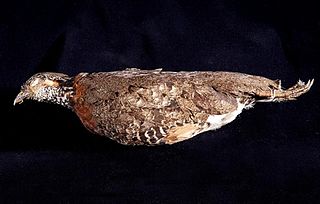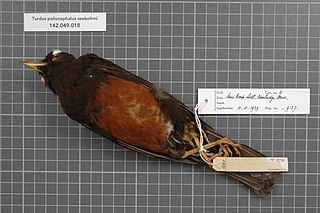
Mount Pueh, also known as Mount Pueh-Berumput, Mount Poi and Mount Poe, is a mountain located near Lundu, Sarawak on the Malaysia-Indonesia border. Mount Pueh was known to biologists for the collections made there by Eric Mjöberg (1882–1938), a Swedish naturalist, who was Curator of the Sarawak Museum between 1922 and 1924. Mjöberg's herpetological collections from Gunung Pueh between October and December 1923, and other localities in Borneo, were reported by Smith (1925). Mjöberg, unfortunately, left little by way of written records, of his ascent of Pueh and the collections he made.

The Mantanani scops owl, is a small owl in the scops-owl genus Otus found on small islands between Borneo and the Philippines. It is listed by the IUCN as "near threatened" because its range is limited with its population being fragmented on several different islands, and its forest habitat is being degraded by ongoing logging and clearance.

The red-legged crake is a waterbird in the rail and crake family, Rallidae.

The chestnut-necklaced partridge is a species of bird in the family Phasianidae. It is found in forests in the Malay Peninsula and Sumatra. It is threatened by habitat loss and trapping. The International Union for Conservation of Nature (IUCN) has assessed it as vulnerable.

The red-breasted partridge, also known as the Bornean hill-partridge, is a species of bird in the family Phasianidae. It is endemic to hill and montane forest in Borneo, preferring bamboos and thickets. The International Union for Conservation of Nature (IUCN) has assessed it as a least-concern species.

The long-billed partridge is a species of bird in the family Phasianidae.

Rhizothera is a bird genus in the family Phasianidae, native to Malaysia and Indonesia. They are the only genus in the tribe Rhizotherini. Established by George Robert Gray in 1841, it contains the following species:

The cream-vented bulbul is a member of the bulbul family of passerine birds. It is found in south-eastern Asia from the Malay Peninsula to Borneo. Its natural habitat is subtropical or tropical moist lowland forests. Its breast might sometimes look a little yellow.

The Dulit frogmouth is a little-known species of bird in the frogmouth family, Podargidae, with a patchily recorded distribution in the mountain forests of northern and central Borneo to which it is endemic. The species is monotypic.

The mountain blackeye, sometimes referred to as the olive blackeye or simply black-eye, is a species of passerine bird in the family Zosteropidae. It is endemic to the highest mountains on the island of Borneo. It is known from both Malaysian states on the island, and four of the five Indonesian provinces, but has never been recorded in Brunei. Typically found at elevations above 1,800 m (5,900 ft), the mountain blackeye sometimes moves to lower altitudes during periods of drought. There are four subspecies, which show clinal variations in size and coloring. Birds in the north are largest, darkest, and proportionately longer-tailed, while those further south are smaller, paler, and proportionately shorter-tailed. Adults are dark olive-green with a sharply-pointed, bright yellow-orange bill and a small dark mask connecting black lores with a black eye-ring. The subspecies show varying amounts of yellow in their plumage, particularly on the face and underparts. Young birds resemble their parents, but have less brightly colored bills.

The black-sided flowerpecker, also known as the Bornean flowerpecker, is a species of bird in the family Dicaeidae. It is endemic to the island of Borneo, where it is found in the mountains, primarily above 1,000 m (3,300 ft) in elevation. The species is sexually dimorphic. The male has glossy blue-black upperparts, with a scarlet throat and breast, a dark grey upper belly, olive flanks, a white lower belly, and a buffy vent and undertail coverts. The female is olive-green above and greyish below, with buffy flanks and a whitish throat. It inhabits a range of forest habitats, including primary and secondary montane forest, kerangas forest, and scrub, and is also occasionally found in gardens. It feeds primarily on small fruits—particularly mistletoe berries—as well as seeds, nectar, and various invertebrates. It builds a nest of moss, camouflaged on the outside with lichens and lined with the pith of tree ferns. The International Union for Conservation of Nature rates it as a species of least concern. Though its numbers have not been quantified, the black-sided flowerpecker is said to be common throughout much of its range, and any declines are not thought to be precipitous. However, destruction of forest for palm plantations may impact it.

The blue-headed pitta is a species of bird in the pitta family Pittidae. It is endemic to Borneo.

Whitehead's trogon is a species of bird in the family Trogonidae. It is endemic to the island of Borneo, where it is an uncommon resident in primary mountain forest. One of Borneo's largest trogons at 29 to 33 cm long, it is sexually dimorphic. The male is crimson on the head, nape, and underparts, with a black throat and grey chest; the rest of his upperparts are cinnamon-coloured. The female is similarly patterned, but cinnamon-brown where the male is scarlet. The species was first described for science by Richard Bowdler Sharpe in 1888, who named it for British explorer and collector John Whitehead. There are no subspecies.

The Borneo black-banded squirrel is a species of rodent in the family Sciuridae. It is endemic to northern Borneo.

The Borneo thrush, also known as the mountain blackbird or locally in Dusun as Luhui tana, is a bird in the thrush family. It is a subspecies of the island thrush endemic to the island of Borneo.

Mount Dulit is a mountain in Borneo. It peaks at 1,311 metres (4,301 ft) above sea level and stands at the head of the Baram River in northern Sarawak, Malaysia. It is a western outlier of the Bornean cordillera and is largely covered with montane tropical rainforest. It has given its name to various plants and animals including the Dulit frogmouth, Dulit partridge, the frog Rhacophorus dulitensis, the caecilian Ichthyophis dulitensis, the trilobite beetle genus Duliticola and the Vatica dulitensis tree. It is the site from which Charles Hose collected the holotype specimen of the rare and elusive Hose's palm civet in 1891.

The pale-faced bulbul is a songbird in the bulbul family. It is endemic to the island of Borneo.

The Bornean black magpie, also known as the black crested magpie, is a treepie in the family Corvidae. It is endemic to the Southeast Asian island of Borneo.
Vatica dulitensis is a tree in the family Dipterocarpaceae, native to Borneo. It is named for Mount Dulit in Sarawak.


















